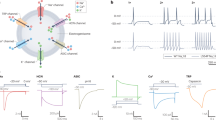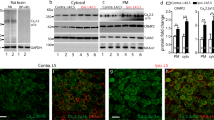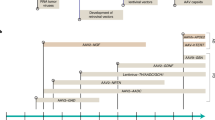Abstract
Peripheral neuropathic pain is one of the most common and debilitating complications of diabetes. Several genes have been shown to be effective in reducing neuropathic pain in animal models of diabetes after transfer to the dorsal root ganglion using replication-defective herpes simplex virus (HSV)1-based vectors, yet there has never been a comparative analysis of their efficacy. We compared four different HSV1-based vectors engineered to produce one of two opioid receptor agonists (enkephalin or endomorphin), or one of two isoforms of glutamic acid decarboxylase (GAD65 or GAD67), alone and in combination, in the streptozotocin-induced diabetic rat and mouse models. Our results indicate that a single subcutaneous hindpaw inoculation of vectors expressing GAD65 or GAD67 reduced diabetes-induced mechanical allodynia to a degree that was greater than daily injections of gabapentin in rats. Diabetic mice that developed thermal hyperalgesia also responded to GAD65 or endomorphin gene delivery. The results suggest that either GAD65 or GAD67 vectors are the most effective in the treatment of diabetic pain. The vector combinations, GAD67+endomorphin, GAD67+enkephalin or endomorphin+enkephalin also produced a significant antinociceptive effect but the combination did not appear to be superior to single gene treatment. These findings provide further justification for the clinical development of antinociceptive gene therapies for the treatment of diabetic peripheral neuropathies.
This is a preview of subscription content, access via your institution
Access options
Subscribe to this journal
Receive 12 print issues and online access
$259.00 per year
only $21.58 per issue
Buy this article
- Purchase on Springer Link
- Instant access to full article PDF
Prices may be subject to local taxes which are calculated during checkout






Similar content being viewed by others
References
Luft D . Neuropathic pain in diabetic nephropathy—update on analgesic strategies. Nephrol Dial Transplant 1999; 14: 2285–2288.
Ziegler D . Painful diabetic neuropathy: treatment and future aspects. Diabetes Metab Res Rev 2008; 24 (Suppl 1): S52–S57.
Kumar S, Ruchi R, James SR, Chidiac EJ . Gene therapy for chronic neuropathic pain: how does it work and where do we stand today? Pain Med 2011; 12: 808–822.
Glorioso JC, Fink DJ . Herpes vector-mediated gene transfer in the treatment of chronic pain. Mol Ther 2009; 17: 13–18.
Fink DJ, Wechuck J, Mata M, Glorioso JC, Goss J, Krisky D et al. Gene therapy for pain: results of a phase I clinical trial. Ann Neurol 2011; 70: 207–212.
Chattopadhyay M, Mata M, Fink DJ . Continuous delta-opioid receptor activation reduces neuronal voltage-gated sodium channel (NaV1.7) levels through activation of protein kinase C in painful diabetic neuropathy. J Neurosci 2008; 28: 6652–6658.
Goss JR, Mata M, Goins WF, Wu HH, Glorioso JC, Fink DJ . Antinociceptive effect of a genomic herpes simplex virus-based vector expressing human proenkephalin in rat dorsal root ganglion. Gene Ther 2001; 8: 551–556.
Wolfe D, Hao S, Hu J, Srinivasan R, Goss J, Mata M et al. Engineering an endomorphin-2 gene for use in neuropathic pain therapy. Pain 2007; 133: 29–38.
Liu J, Wolfe D, Hao S, Huang S, Glorioso JC, Mata M et al. Peripherally delivered glutamic acid decarboxylase gene therapy for spinal cord injury pain. Mol Ther 2004; 10: 57–66.
Chattopadhyay M, Mata M, Fink DJ . Vector-mediated release of GABA attenuates pain-related behaviors and reduces NaV1.7 in DRG neurons. Eur J Pain 2011; 15: 913–920.
Hao S, Mata M, Glorioso JC, Fink DJ . HSV-mediated expression of interleukin-4 in dorsal root ganglion neurons reduces neuropathic pain. Mol Pain 2006; 2: 6.
Peng XM, Zhou ZG, Glorioso JC, Fink DJ, Mata M . Tumor necrosis factor-alpha contributes to below-level neuropathic pain after spinal cord injury. Ann Neurol 2006; 59: 843–851.
Yeomans DC, Lu Y, Laurito CE, Peters MC, Vota-Vellis G, Wilson SP et al. Recombinant herpes vector-mediated analgesia in a primate model of hyperalgesia. Mol Ther 2006; 13: 589–597.
Giuditta A, Chun JT, Eyman M, Cefaliello C, Bruno AP, Crispino M . Local gene expression in axons and nerve endings: the glia-neuron unit. Physiol Rev 2008; 88: 515–555.
Jiang Y, Nyengaard JR, Zhang JS, Jakobsen J . Selective loss of calcitonin gene-related Peptide-expressing primary sensory neurons of the a-cell phenotype in early experimental diabetes. Diabetes 2004; 53: 2669–2675.
Morrow TJ . Animal Models of Painful Diabetic Neuropathy: The STZ Rat Model. Current Protocols in Neuroscience. John Wiley & Sons: Somerset, 2004, pp 9.18.1–9.18.11.
Pabbidi RM, Yu SQ, Peng S, Khardori R, Pauza ME, Premkumar LS . Influence of TRPV1 on diabetes-induced alterations in thermal pain sensitivity. Mol Pain 2008; 4: 9.
Wodarski R, Clark AK, Grist J, Marchand F, Malcangio M . Gabapentin reverses microglial activation in the spinal cord of streptozotocin-induced diabetic rats. Eur J Pain 2009; 13: 807–811.
Pinal CS, Tobin AJ . Uniqueness and redundancy in GABA production. Perspect Dev Neurobiol 1998; 5: 109–118.
Karlsen AE, Hagopian WA, Grubin CE, Dube S, Disteche CM, Adler DA et al. Cloning and primary structure of a human islet isoform of glutamic acid decarboxylase from chromosome 10. Proc Natl Acad Sci USA 1991; 88: 8337–8341.
Soghomonian JJ, Martin DL . Two isoforms of glutamate decarboxylase: why? Trends Pharmacol Sci 1998; 19: 500–505.
Moore KA, Kohno T, Karchewski LA, Scholz J, Baba H, Woolf CJ . Partial peripheral nerve injury promotes a selective loss of GABAergic inhibition in the superficial dorsal horn of the spinal cord. J Neurosci 2002; 22: 6724–6731.
Castro-Lopes JM, Tavares I, Coimbra A . GABA decreases in the spinal cord dorsal horn after peripheral neurectomy. Brain Res 1993; 620: 287–291.
Hao S, Mata M, Wolfe D, Huang S, Glorioso JC, Fink DJ . Gene transfer of glutamic acid decarboxylase reduces neuropathic pain. Ann Neurol 2005; 57: 914–918.
Kim J, Kim SJ, Lee H, Chang JW . Effective neuropathic pain relief through sciatic nerve administration of GAD65-expressing rAAV2. Biochem Biophys Res Commun 2009; 388: 73–78.
Lee B, Kim J, Kim SJ, Lee H, Chang JW . Constitutive GABA expression via a recombinant adeno-associated virus consistently attenuates neuropathic pain. Biochem Biophys Res Commun 2007; 357: 971–976.
Coull JA, Boudreau D, Bachand K, Prescott SA, Nault F, Sik A et al. Trans-synaptic shift in anion gradient in spinal lamina I neurons as a mechanism of neuropathic pain. Nature 2003; 424: 938–942.
Jolivalt CG, Lee CA, Ramos KM, Calcutt NA . Allodynia and hyperalgesia in diabetic rats are mediated by GABA and depletion of spinal potassium-chloride co-transporters. Pain 2008; 140: 48–57.
Cavanaugh DJ, Lee H, Lo L, Shields SD, Zylka MJ, Basbaum AI et al. Distinct subsets of unmyelinated primary sensory fibers mediate behavioral responses to noxious thermal and mechanical stimuli. Proc Natl Acad Sci USA 2009; 106: 9075–9080.
Kubo K, Nishikawa K, Ishizeki J, Hardy-Yamada M, Yanagawa Y, Saito S . Thermal hyperalgesia via supraspinal mechanisms in mice lacking glutamate decarboxylase 65. J Pharmacol Exp Ther 2009; 331: 162–169.
Carlton SM, Zhou S, Coggeshall RE . Peripheral GABA(A) receptors: evidence for peripheral primary afferent depolarization. Neuroscience 1999; 93: 713–722.
Zhou S, Komak S, Du J, Carlton SM . Metabotropic glutamate 1alpha receptors on peripheral primary afferent fibers: their role in nociception. Brain Res 2001; 913: 18–26.
Sawynok J . Topical and peripherally acting analgesics. Pharmacol Rev 2003; 55: 1–20.
Matthes HW, Maldonado R, Simonin F, Valverde O, Slowe S, Kitchen I et al. Loss of morphine-induced analgesia, reward effect and withdrawal symptoms in mice lacking the mu-opioid-receptor gene. Nature 1996; 383: 819–823.
Fichna J, do-Rego JC, Mirowski M, Costentin J, Janecka A . Binding of endomorphin-2 to mu-opioid receptors in experimental mouse mammary adenocarcinoma. J Pept Res 2005; 65: 459–464.
Obara I, Przewlocki R, Przewlocka B . Local peripheral effects of mu-opioid receptor agonists in neuropathic pain in rats. Neurosci Lett 2004; 360: 85–89.
Tseng LF . The antinociceptive properties of endomorphin-1 and endomorphin-2 in the mouse. Jpn J Pharmacol 2002; 89: 216–220.
Soignier RD, Vaccarino AL, Brennan AM, Kastin AJ, Zadina JE . Analgesic effects of endomorphin-1 and endomorphin-2 in the formalin test in mice. Life Sci 2000; 67: 907–912.
Okada Y, Tsuda Y, Bryant SD, Lazarus LH . Endomorphins and related opioid peptides. Vitam Horm 2002; 65: 257–279.
Janecka A, Kruszynski R, Fichna J, Kosson P, Janecki T . Enzymatic degradation studies of endomorphin-2 and its analogs containing N-methylated amino acids. Peptides 2006; 27: 131–135.
Robinson DS, Schooler NR . Clinical Study Design—Critical Issues. Raven Press: New York, New York, 1995.
Wolfe D, Goins WF, Yamada M, Moriuchi S, Krisky DM, Oligino TJ et al. Engineering herpes simplex virus vectors for CNS applications. Exp Neurol 1999; 159: 34–46.
Grant KG, Krisky DM, Ataai MM, Glorioso JC . Engineering cell lines for production of replication defective HSV-1 gene therapy vectors. Biotechnol Bioeng 2009; 102: 1087–1097.
Chaplan SR, Bach FW, Pogrel JW, Chung JM, Yaksh TL . Quantitative assessment of tactile allodynia in the rat paw. J Neurosci Methods 1994; 53: 55–63.
Hargreaves K, Dubner R, Brown F, Flores C, Joris J . A new and sensitive method for measuring thermal nociception in cutaneous hyperalgesia. Pain 1988; 32: 77–88.
Ortiz MI, Ponce-Monter HA, Fernandez-Martinez E, Macias A, Rangel-Flores E, Izquierdo-Vega JA et al. Pharmacological interaction between gabapentin and glibenclamide in the formalin test in the diabetic rat. Proc West Pharmacol Soc 53: 49–51.
Chen SR, Samoriski G, Pan HL . Antinociceptive effects of chronic administration of uncompetitive NMDA receptor antagonists in a rat model of diabetic neuropathic pain. Neuropharmacology 2009; 57: 121–126.
Dixon WJ . Efficient analysis of experimental observations. Annu Rev Pharmacol Toxicol 1980; 20: 441–462.
Aloe L, Moroni R, Angelucci F, Fiore M . Role of TNF-alpha but not NGF in murine hyperalgesia induced by parasitic infection. Psychopharmacology 1997; 134: 287–292.
Chomczynski P, Sacchi N . Single-step method of RNA isolation by acid guanidinium thiocyanate-phenol-chloroform extraction. Anal Biochem 1987; 162: 156–159.
Acknowledgements
This work was supported by USAF/AFMC FA 7014-10-2-0002, Clinical Gene Therapy.
Author information
Authors and Affiliations
Corresponding author
Ethics declarations
Competing interests
JW, DK, JG and DW are employees of Diamyd Inc., where HSV1-based vectors used in this study were manufactured. The remaining authors declare no conflict of interest.
Additional information
Supplementary Information accompanies the paper on Gene Therapy website
Supplementary information
Rights and permissions
About this article
Cite this article
Wang, Y., Nowicki, M., Wang, X. et al. Comparative effectiveness of antinociceptive gene therapies in animal models of diabetic neuropathic pain. Gene Ther 20, 742–750 (2013). https://doi.org/10.1038/gt.2012.90
Received:
Revised:
Accepted:
Published:
Issue Date:
DOI: https://doi.org/10.1038/gt.2012.90



